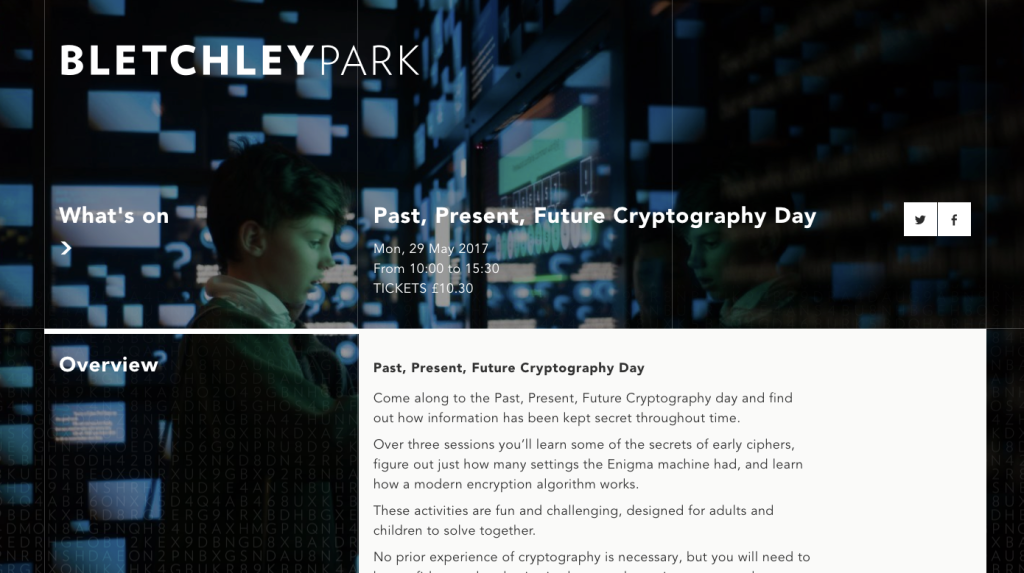Case Study: Bletchley Park - Past, Present, Future: Cryptography
Organisations involved: Bletchley Park, Tom Briggs
Case study written by: Tom Briggs
Intended audience: Adult, non-specialist members of the public
Maths content: Codes and codebreaking, History of Cryptography
Audience group: Adults, Retired
Audience interest level: Receptive, Engaged
Topics: Codes and cryptography, History

Origins of the Project
Past, Present, Future: Cryptography was a standalone (but repeatable) activity intended to “test the waters” regarding the desire for, and enjoyment of, events marketed at the general public that were developed using ideas, experiences and skills usually reserved for Bletchley Park’s formal education programme.
I had long entertained an idea of some sort of “codebreaker training course” accessible to people who were interested in finding more about how codes and ciphers work, but who did not necessarily see themselves as a “maths person”. The event was aimed at adult, non-specialist members of the public with an interest in codes, ciphers and Bletchley Park.
Practicalities
The events were “full day” courses lasting from 10:30 – 15:30 with attendees expected to stay all day. The events took place on site at Bletchley Park in Block B, and the ticket cost (£10.30) included a day pass to visit the rest of the site.

The first session (“Past”) presented them with a locked briefcase and a booklet of puzzles. An introductory puzzle was projected at the front of the room. Completing this told them how to get started on the rest.
The puzzles were all based on real codes and ciphers, and were accompanied by historical notes with a quick overview of their background. Tips and codebreaking tricks were dished out, many of which are mathematical in nature and link to areas of mathematics that many participants remembered from their school days.
The second session was a tour around Bletchley Park to put the rest of the day into its historical context.
The third session (“Present” – that is, the present as far as BP’s codebreakers are concerned) was built around using information gathered from the first session to learn about how an Enigma machine works, using a simulator to decode a message “received” at the beginning of the session, and utilising some of its weaknesses to find missing settings.
The fourth session (“Future” – from the point of view of the WW2 codebreakers), following a lunch break, follows postwar developments in cryptography, culminating in a section which takes participants through encrypting and decrypting a message using a simplified version of RSA encryption by hand. A discussion of some of RSA’s apparent weaknesses built up to a (very) brief look at quantum cryptography.
Accessibility
The assumption was made when producing the course that most participants would have had no experience with codes and ciphers in the past. Care was taken to produce resources with accessible print sizing, and larger-print versions were available if requested.
Activities & questioning were included from the beginning that played up to common misconceptions, inviting common incorrect answers from participants (e.g., “what is Morse code used for?” usually prompts a response along the lines of “keeping secrets.”) These incorrect responses were praised and encouraged, and it was often the case that most participants thought the same thing. This was used to reduce anxiety around “getting the answer wrong” which often causes people (particularly adults!) to be reticent about joining in.
Evaluation
Evaluation of the project was achieved by handing out evaluation sheets and encouraging participants to fill them in, largely as an exercise to determine the commercial viability of developing the series further (i.e. did participants feel that the experience was worth paying for; would they be prepared to pay the same amount for a “sequel”) as it was necessary to justify learning activities against this metric to get approval from the organisation’s leadership.
As educators in an environment heavily geared towards income generation, pedagogical merit was highly important to us, but leadership generally responded to assessments of educational (rather than financial) worth with indifference, so evaluation on this side of things was done mainly for our own benefit and, to a certain extent, conducted “under the radar”: There was a free-text response on the evaluation sheet which we encouraged participants to use to make general statements about their experiences through the event, and comments such as “I hadn’t realised maths could be so much fun/ interesting” were common.
We also made an effort to engage with participants individually, and received many positive comments regarding the content, delivery and general theme of the event. At the end of each event we made it clear that participants were welcome to stay and ask questions should they have any, and while most left at that point, up to a quarter of the participants stayed behind for different lengths of time.
Many had more probing questions about the Enigma machine that was used during the event; some wanted more specific references to further reading than the general books and websites we recommended during the sessions; a few had more specific tales and observations. One memorable example was a person who signed up because they worked in a lab next to one researching quantum cryptography, and wanted to understand more of the background.
More information
Bletchley Park website: bletchleypark.org.uk/